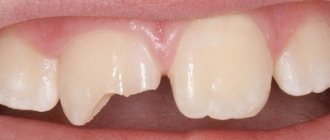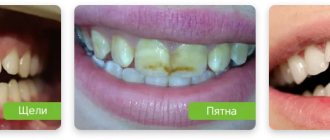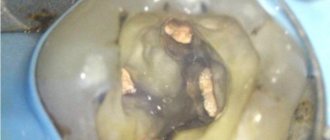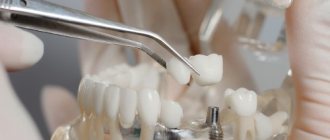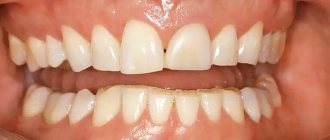2191
The most common method of attaching bridges is to secure them with full crowns placed over the abutment teeth.
To do this, the latter are sanded off on all sides, which leads to a deterioration in their condition and an irreversible loss of aesthetics.
There are, however, other, more gentle ways to attach the MP. One of them is fixation of half-crowns.
General overview
A partial crown is a small, non-removable orthopedic structure that covers four surfaces of the tooth - oral (lingual), two proximal (lateral) and chewing (incisal).
The vestibular (buccal, labial) surface remains uncovered. Typically, partial crowns are placed on premolars and front teeth. They are sometimes called “three-quarter teeth,” although they actually cover 4/5 of the tooth surface.
Most often, half-crowns are used as supporting elements of bridge or clasp prostheses. Unlike full crowns, they do not impair the aesthetics of the supporting tooth, the vestibular part of which remains intact.
Sometimes half-crowns are used as fastening elements for splinting structures.
In general, there are quite a few types of partial crowns. There are ceramic structures similar to veneers. They cover the tooth from the vestibular side and are applied solely to improve the aesthetics of the defective tooth. Therefore, it is more correct to call this type of crown “veneering.”
There are “seven-octagonal” designs that leave only the mesiobuccal cusp open. Due to the relative rarity of such designs, this article will discuss only the traditional types of partial crowns – “three-quarter” crowns.
Half-crowns are made using casting from stainless steel, KHS, gold and silver-containing alloys (silver-palladium, gold-platinum).
To secure the cast product on the tooth, the latter is prepared (ground) on 4 sides to form U-shaped grooves on the occlusal, distal and medial surfaces.
They play the same role as the labial side of a full crown. The grinding thickness should be no less than the thickness of the metal - about 0.3-0.5 mm.
The design of the half-crown structure in each specific case is determined by the doctor, taking into account the clinical picture and the general principles that apply to this type of orthopedic products.
The “three-quarter” structure is attached to the prepared tooth using cement. To ensure more reliable fixation, parapulp pins can be used - thin rods installed vertically in the space between the pulp chamber and the tooth wall.
The first signs of an allergy to crowns and ways to eliminate the problem.
Read here about the features of glass-ceramic crowns.
At this address https://www.vash-dentist.ru/protezirovanie/nesemnyie-p/koronki-np/metallokeramiki-shofu-halo.html you will find all the most important things about Shofu Halo metal ceramics.
Aesthetic dental restoration
| Aesthetic tooth restoration with filling I, V, Black class using materials from photopolymers (Fissure area) | 6800 rub. |
| Aesthetic tooth restoration with a filling, class II according to Black, using materials from photopolymers (1 contact surface, chewing group of teeth) | 8200 rub. |
| Aesthetic restoration of a tooth with a filling, class II according to Black, using materials from photopolymers (2 contact surfaces, chewing group of teeth) | 10500 rub. |
Indications and contraindications
Half-crowns are a relative rarity in the arsenal of dentists. They are usually used in the following cases:
- As a supporting element for a bridge or clasp structure, if the goal is to preserve the front part of an intact tooth intact, and also to avoid unnecessary and unaesthetic exposure of a full metal crown.
- As a fastening element for splinting systems.
- As supporting devices when installing inlays in clinical situations when strong fastening of the latter is impossible without additional strengthening of the tooth. Half-crowns perform the function of such reinforcing structures.
Contraindications
The main obstacle to installing half-crowns are some design features and the insufficiently good condition of the supporting teeth:
- Caries.
- Small area or destruction of chewing surfaces.
- Severe defects of the approximal surfaces.
- Low tooth height, when it is difficult to ensure reliable fixation, and in addition, there is a risk of opening the pulpous chamber.
- There is a danger of weakening the buccal cusp during its preparation.
- The walls of the pulp chamber are too thin.
- Mobility of support units.
- Deep bite. Due to the need to grind down too thick a layer of enamel and dentin on the palatal side, there is a danger of opening the pulpous chamber.
It is not recommended to use half-crowns even with a long bridge.
Let's start restoring your smile
Upper row of teeth
We ground the top, we only had 7 living teeth from the top, 3 of our teeth were pulpless. They did 7 anesthesia on the top and 9 teeth on the bottom. They were alive, that is, 9 out of 10 teeth were alive. Only one tooth was depulped with a filled canal.
Due to the fact that the teeth were initially destroyed, the gums were very inflamed and bled VERY heavily
.
And because the gums were bleeding, they had to stop the bleeding. As a result, the gums darkened, but this quickly passes. We have drugs that stop the bleeding in the process, the gums then heal and become absolutely perfect over a short time, literally in a few days. This, by the way, is extremely rare, but it happens.
Angelina, despite her young age, had a very neglected situation - her gums were under the filling-tooth border, plaque, rot and microbes were always accumulating there. That's why she bled at the slightest touch.
We place temporary veneers
Photo shows temporary teeth
, completely made in the office immediately, with one monolithic structure. Not on Tserek, not in the laboratory, but just by me in the office. Do you recognize the girl? 
And pay attention, the central upper teeth are made of full-fledged crown + root modules.
All teeth were restored with veneers alone, without inlays:
All veneers were of different designs - that is, standard veneers
Also, some veneers were
a module with a root
, and on chewing teeth, teeth were restored with
half-crown
.
Please note that the veneers for Angelina were made in the laboratory.
When
the top was fixed
, the patient was super happy, she even burst into tears in the office:
Pros and cons of products
The main advantage of half-crowns is the increased aesthetics of the abutment teeth covered with them due to the preservation of the integrity of the frontal surface.
The safety of the tooth and gums also increases compared to technology that uses a full crown.
Minuses:
- significant labor intensity of preparation of the supporting unit;
- high requirements for the doctor’s qualifications due to the complex configuration of the treatment area.
The treatment took place in 3 stages
General treatment concept
They immediately did total work on 10 teeth on top
and
10 teeth on the bottom
.
For the top we chose the color 1M1
- it is a wonderful natural and very light color, without excesses of beauty. A lighter color always suits fashion girls very well.
First, we made the top and created a virtual vox-up
- a 3D model of Angelina’s future smile. Voxap visualizes very clearly - it shows the patient how future veneers will look on the teeth and in the photo. We can also, looking at a computer model of the face, geometrically change many aesthetic factors, such as the size and shape of the teeth, their sharpness and relief. 3D planning takes 1 week.
Manufacturing technology
The production of half-crowns involves a series of sequential clinical and laboratory procedures.
The choice of design is made based on diagnostics.
Preparation
A layer of enamel and dentin 0.6-1 mm thick is sanded off from the lingual, two lateral and chewing (cutting) surfaces.
The parallelism of the side surfaces must be checked. A slight inclination is allowed - convergence of 3-5° in the oral direction, so that the instructions can be easily put on and taken off when fitting.
It is advisable to provide an inclination in the chewing area. A U-shaped notch with a depth of no more than 1.5 mm is made on the occlusal and proximal surfaces.
The grooves on the side surfaces are made parallel to each other and shifted closer to the outer (vestibular) surface.
Grinding of the cutting edge of the tooth is carried out in such a way that the edge of the metal model is not visible from the front side.
Preparation methods may vary depending on the technique used - Vect or Elander. It is convenient to control the grinding depth by using a fissure bur of the appropriate size.
Techniques for tooth crown repair and how justified the procedure is.
In this article we will tell you why teeth hurt after crown removal.
Follow the link https://www.vash-dentist.ru/protezirovanie/nesemnyie-p/koronki-np/metallokeramicheskih-vita.html if you are interested in the characteristics of the Vita metal-ceramic crown.
Taking impressions
An impression is taken of the prepared tooth and the antagonist row. To obtain an impression, masses are used that give the most accurate impression.
The next stage is the production of plaster models from the impression and their processing.
Wax modeling
Before applying wax, the plaster tooth is coated (isolated) with varnish, oil or petroleum jelly. This is necessary to ensure that the wax cap can be easily removed.
Various modeling techniques are used. All of the wax can be applied by hand, or the capping technique is used, which involves first dipping a model of the tooth into molten wax to form a cap, which is then finished by hand.
First, wax is applied to the grooves. After application, it is pressed onto the model with your fingers until it hardens.
The thickness of the wax should be 0.3-0.4 mm. When modeling the chewing and cutting surfaces, the bite is controlled - manually or in an articulator. In this case, the dentition models must be installed in the position of central occlusion.
Casting
This is the most complex and responsible operation, which essentially consists of replacing wax with metal.
The flyer is installed in the zone of transition of the lingual surface to the chewing area - parallel to the longitudinal axis of the tooth.
A mold is made and fired, in which, instead of wax, a cavity is formed, filled with molten metal.
The last stage is fitting to the model with processing and removal of all irregularities and sagging.
Fitting in the mouth
The quality of the fit depends on the accuracy of the casting. Even the smallest burrs can disturb it, so they must be removed.
Before placing the half-crown on cement, it is necessary to remove the smallest gaps between it and the tooth.
Fixation of a half-crown
This is done using cement (cement phosphate). If the product is made of soft metal (silver-palladium alloy, gold).
Before the cement hardens, it is useful to roll (core) its edges for better fixation.
Notes
- The wall of the half-crown should enter the gingival pocket by 0.3 mm.
- When modeling, the wax should not extend onto the labial/buccal surface of the tooth, otherwise there will be problems with its removal and fixation of the finished crown.
- When casting a product, it is necessary to take into account metal shrinkage, which varies depending on the material.
The gold-platinum alloy shrinks slightly, while stainless steel shrinks significantly. When using it during modeling, it is recommended to cover the gypsum abutment tooth with tin foil, the thickness of which is 0.02-0.03 mm. To remove wrinkles, you can use the Parker apparatus. - When making a half-crown for pulpless teeth, a pin can be cast along with it and inserted into the root canal.
In the video, a specialist will talk about the features of restoring teeth with veneers, crowns and half-crowns.
Treatment of caries of the chewing teeth
| Tooth restoration with inlays, veneers, half-crowns made of photopolymer material using the direct method | 10,000 rub. |
| Applying a temporary filling | 500 rub. |
| Restoring a tooth with a filling I, II, III, V, VI class according to Black using chemical curing materials (preparation for a crown) | 3850 rub. |
| Tooth restoration with a filling I, V, Black class using materials from photopolymers | 4900 rub. |
| Tooth restoration with a Black class II filling using chemically cured materials using a fiberglass pin | 5500 rub. |
| Tooth restoration with a filling, class II according to Black, using materials from photopolymers (1 contact surface) | 6000 rub. |
| Tooth restoration with a filling, class II according to Black, using materials from photopolymers (2 contact surfaces) | 6500 rub. |
| Sealing the tooth fissure with sealant | 3300 rub. |
Service life and cost
The service life of a half-crown used as an element for fastening a bridge depends on the following indicators:
- service life of the problematic element;
- the material from which the model is made;
- condition of supporting teeth;
- operating conditions of the prosthesis.
In general, with good quality supporting units and proper operation, the service life of a bridge can be from 5 to 15 years.
The price of a half-crown depends mainly on the material from which it is made. The cheapest option - a steel structure will cost from 1000 rubles.
A design made of chromium-cobalt alloy will cost at least 3000-4000 rubles.
Ceramic veneering for the front part of a tooth can cost from 28,000 rubles.
Finish of treatment
We made 20 teeth: first the top, then the bottom. Creating a smile took 19 days, that is, we sharpened the bottom when we fixed the top (about 12 days from the very first appointment). And the grinding of the lower teeth began on the same day when the veneers were fixed on the upper jaw. Then, after 7 days, a permanent bottom was recorded. All veneers in color 1M1
.
Rightmost photo 3
done immediately after installation.
Yes, there were tears of joy and words of gratitude: “Sergey Sergeevich, you are the best orthopedist
in Moscow!” ))).
Well, then, two weeks later, Angelina came to me for a photo shoot, all beaming with a happy smile:
It was a good job. And in the end - an absolutely happy patient
!
Reviews
Typically, bridges are secured using full crowns. Making them and preparing a tooth for them is a routine operation for dentists and technicians.
Not every doctor would think of suggesting that a patient have a half-crown installed.
If you have such a relative rarity installed in your mouth, please share your impressions and experience of using it. You can do this by leaving a review at the bottom of this page.
If you find an error, please select a piece of text and press Ctrl+Enter.
Tags dental crowns fixed dentures
Did you like the article? stay tuned
Previous article
Sky implants – high-tech systems for patients of all age groups
Next article
Three reasons to stop wearing fake braces
Treatment of caries of the anterior group of teeth
| Tooth restoration with inlays, veneers, half-crowns made of photopolymer material using the direct method | 10,000 rub. |
| Applying a temporary filling | 800 rub. |
| Restoring a tooth with a filling I, II, III, V, VI class according to Black using chemical curing materials (preparation for a crown) | 3500 rub. |
| Tooth restoration with filling I, II, III, V, VI class according to Black using materials from photopolymers | 3850 rub. |
| Tooth restoration with a filling I, V, Black class using materials from photopolymers | 4700 rub. |
| Tooth restoration with a Black class II filling using chemically cured materials using a fiberglass pin | 4900 rub. |
| Tooth restoration with a filling, class II according to Black, using materials from photopolymers (1 contact surface) | 6100 rub. |
| Tooth restoration with a filling, class II according to Black, using materials from photopolymers (2 contact surfaces) | 6900 rub. |
| Restoring a tooth with a filling, class IV according to Black, using materials from photopolymers | 8900 rub. |
